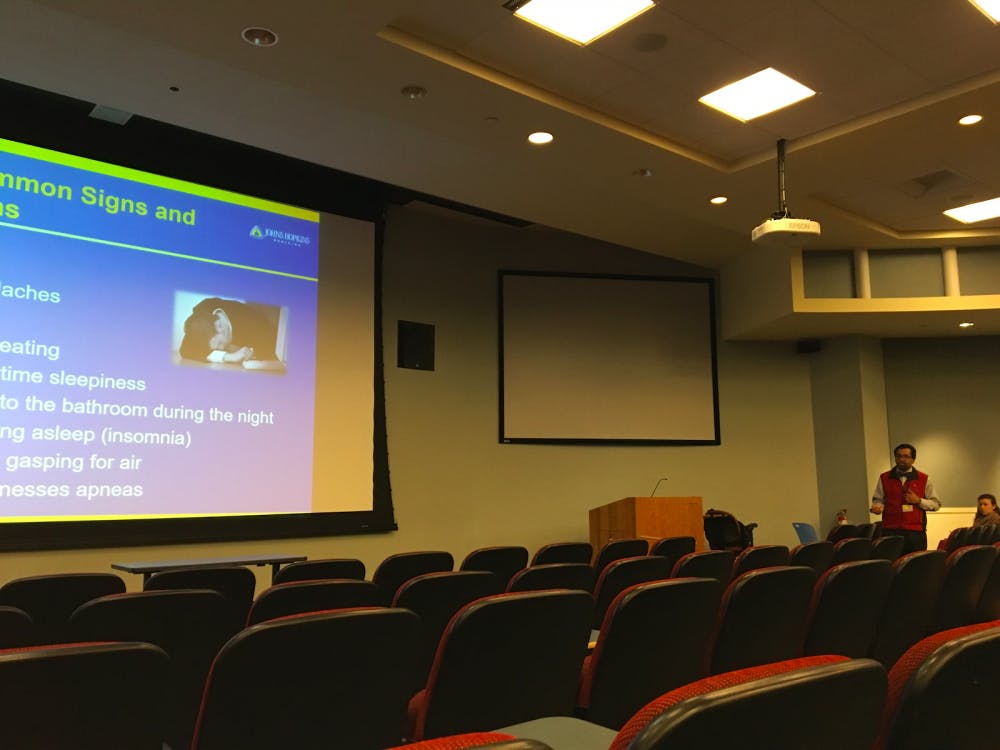In light of Sleep Awareness Week coming up this week, the Center for Health Education & Wellness (CHEW) and Nu Rho Psi co-hosted an event in Hodson 110 called “Sleep 101” on March 6.
This event sought to provide tips to students on how to make the most out of the sleep they get each night. Susheel Patil, clinical director of the Johns Hopkins Sleep Medicine Program, was invited to speak about issues centering around sleep. Patil’s research interest lies in understanding the development of obstructive sleep apnea. He is the author of more than 30 publications and has been invited to give lectures across the U.S.
Patil’s most recent publication described how diet and exercise can help prevent obstructive sleep apnea (OSA). The study, published in the European Respiratory Review, found that calorie restricted diets can help to improve obstructive sleep apnea.
The symptoms of obstructive sleep apnea include upper airway obstruction during sleep and insomnia, but a variety of other symptoms can also be present. According to the study, Ninety percent of cases in men and 98 percent of cases in women may go undiagnosed every year.
Furthermore, the study cited exercise as another potential treatment. The study found that adults who exercised a moderate amount (three times a week) had a reduction of obstructive sleep apnea symptoms. In addition, these improvements were observed separately from weight loss, meaning that exercise may be directly related to OSA improvement.
“One hypothesis is that moderate exercise reduces fluid accumulation in the legs and nocturnal rostral fluid shift,” Patil and his co-authors wrote in the study.
At the end of his presentation last Monday, Patil mentioned his research and brought up the idea that sleep disorders are treatable and told his audience to talk to their physicians if they ever run into any concerning sleep problems.
Insun Yoon, a sophomore who attended the “Sleep 101” event, shared that she came to the event because she wanted to learn more about how to perform better under conditions of fewer hours of sleep.
“I wondered if there was a way to be more rested without necessarily getting more hours of sleep,” she said. “As a student, I feel that there a lot of pressure to perform well under sleepless conditions, and so I attended because the thought of productive sleep allured me.”
Yoon said that the most interesting thing she took away from this event was that insomnia is not actually considered a disorder.
“Insomnia is not a disorder in itself, but can be seen as a symptom! It is kind of scary to think that insomnia is so common because that means any underlying diseases that insomnia is merely a symptom of are also common,” Yoon said.
In addition to speaking about sleep disorders in his talk, Patil gave a brief introduction to sleep biology as a gateway to understanding the current treatments for various sleep disorders, in addition to tips that can improve sleep quality.
“What I wanted to do with today’s talk is to do a little bit of sleep biology 101, because I think if you understand a little bit about sleep and the science behind it, you will have a better understanding of the treatments and things I will talk about in terms of trying to improve sleep,” Patil said.
However, Patil admitted that scientists to this date still do not understand the purpose behind sleep. Although there are a variety of different theories, none of them have gained substantial acceptance.
In his presentation, Patil listed four main theories on the purpose of sleep that exist today: inactivity for survival, energy consumption, restoration and brain plasticity. Patil also emphasized that the area of brain plasticity research in sleep is currently a very popular topic in the field.
“Brain plasticity is probably the newest theory that many scientists are looking into in terms of research,” he said. “There is this constant sort of creation and pruning [of synapses]. As a result of that, this may be important to memory development and functional development in life.”
Patil further went along to address the approximate hours of sleep humans need throughout their life.
“In terms of how much sleep we need, this changes over the course of a lifespan. Very early on, infants need somewhere in between 12 to 16 hours of sleep a day,” Patil said.
He showed in his figure that high schoolers between the ages of 13 to 18 need approximately eight to 10 hours of sleep per day.
Adults that are 18 or above need at least seven hours of sleep per day. However, Patil stresses that it is important to note that these numbers can vary from person to person.
“These are normative data,” Patil said. “How much sleep any individual needs is going to vary. I see certain people that get six hours of sleep and can actually do very well.”
Patil also presented an interesting figure that compared sleep loss with drunkenness. Past research has shown that staying awake 20 to 24 hours leads to performance similar to when the blood alcohol concentration (BAC) is 0.1 percent.
Patil also added that sleep loss can lead to higher rates of obesity and heart diseases.
The most important tip Patil suggested for people who seek to improve their sleep is to learn to make sleep a priority.
“The bottom line is that there is no shortcut. If you are having insomnia issues or having timing issues with your sleep, it really does require that you make sleep a priority for yourself,” Patil said.
Patil also strongly suggested his audience to stop all electronics 30 to 60 minutes before bed. He encouraged people to not make the brain accustomed to the notion that bed is a place of activity. Besides that, Patil also emphasized the importance of having consistent sleep and rise times.





